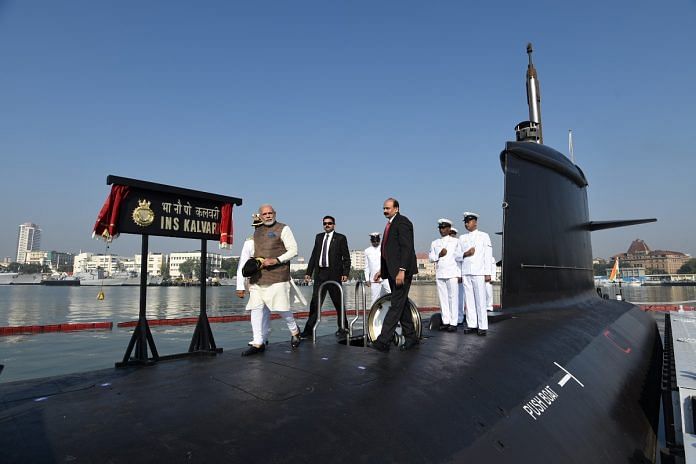The Kalvari or Scorpene deal faced attacks on all sides— by politicians, the bureaucracy, CAG and even CBI since its controversial signing in 2005.
New Delhi: The minefields and torpedoes that INS Kalvari survived before its commissioning by Prime Minister Narendra Modi Thursday would have capsized many a sturdy boat and sunk more than a few hearts.
The latest conventional submarine to join the Indian Navy—after an almost two-decade gap that saw the last new Russian origin Kilo class getting commissioned—has had an unsteady 12-year run through the Indian defence procurement system.
The Kalvari or Scorpene project faced attacks on all sides—by politicians (from the BJP incidentally), the bureaucracy, the auditor general and even a surprise assault by the CBI since the controversial signing of the deal in 2005.
First strike
While it was signed in 2005, the Scorpene deal had a few similarities with that of the Rafale fighter jet and the controversy that now surrounds it. It involved a government-to-government deal with the French, chosen despite strong protests from the Germans who were offering the HDW 214 class with transfer of technology.
The main opposition party, convinced that there was a scandal in the contract, launched a frontal offensive alleging overpricing and corruption. In this case, the opposition was the NDA and leading the attack were stalwarts such as George Fernandes. Under attack was the then defence minister Pranab Mukherjee.
In March 2006, the BJP launched a particularly strong attack on the Congress for alleged corruption in the Scorpene deal. The face of this assault was then party spokesperson and current Union minister Prakash Javadekar.
The Congress government, however, stuck to its guns and went ahead on the procurement. What this unleashed was a massive campaign against the Scorpene deal.
Enter the dragon
The political storm was weathered by the UPA and Mukherjee but not before the CBI and the CAG took a shine to the case. The CBI inquiry into the infamous naval war room leaks case was directed towards allegations of corruption and bribery in the Scorpene deal as well.
However, in July 2008, the CBI informed the Delhi High Court that it found no evidence of kickbacks or money laundering in the Scorpene deal.
The respite was short lived, however, with the CAG coming down hard on the government in July 2009 for “undue favours” to French firms and an increase in costs. The CAG listed four major issues:
— Price increased by Rs 2,383 crore as the government took nine years to conclude the deal.
— The Navy and defence ministry diluted requirements to favour French firms in the acquisition process.
— The French side was given undue financial benefits, specially a price escalation clause of 11.06 per cent.
— A clause banning commissions to agencies was not signed.
Hitting the speed barrier
By 2010-11, it became clear that the Scorpene project was hopelessly behind time. Originally scheduled to be inducted in 2012, the project got delayed by five years due to trouble in absorbing technology and production issues.
In 2011, a big setback occurred with a massive breach and flooding at the Mazgaon Docks Limited (MDL) where the submarines were being made. The breach of the dry dock was one of the several technical issues that hit the Scorpene project, other being delays in ordering equipment from France and labour-related issues.
According to the original contract, the first Scorpene had to come by December 2012, followed by one submarine a year and the entire fleet to be inducted by 2017. With all this clearly appearing impractical, plans were redrawn, to change the delivery schedule.
An upset Navy demanded the first boat by 2015, a deadline that was again not met. It was in August 2015, however, that the first boat was launched in water, paving the way for trials and subsequent commissioning.
The Agusta shadow
The shadow of the AgustaWestland VVIP chopper scam was also looming over the Scorpene deal. The main weapon of the submarine, Black Shark, was selected in advance.
The Black Shark—a heavyweight torpedo to take down enemy ships and submarines—is made by Italian company WAAS, a subsidiary of Finmeccanica, the Italian parent firm of AgustaWestland. However, with the Agusta controversy engulfing the entire group, the Black Shark procurement hung in suspension, to be formally rejected by the government in 2016.
This means that the advanced submarine has been commissioned without its most potent weapon. A substitute has been the older generation SUT torpedo that India operates from its Shishumar (HDW) class. A fresh process is on to select a new torpedo.
The big leak
The last controversy to engulf the project was a massive breach of data that its French manufacturer faced in August 2016. The leak—thousands of pages of blueprints and plans published by an Australian newspaper—caused an uproar as it contained information on noise levels, sonar characteristics, endurance and manoeuvrability and combat system information, among others.
An assessment by the Navy, however, played down the breach, saying that 90 per cent of the information was commercially available and the most critical data on weapon systems was not leaked.






